12 Tips to Help You Sleep Well on the Trail
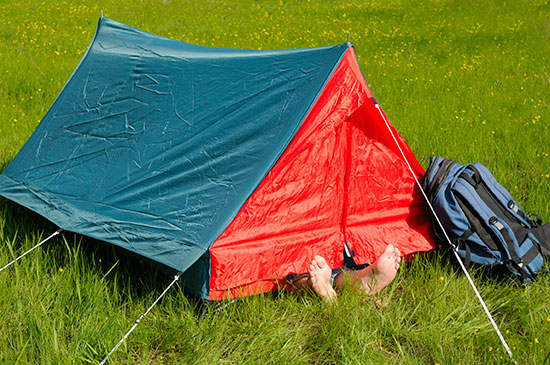
You’re trying to sleep, but there’s a baseball-size rock poking you in the back. You keep sliding downhill in your sleeping bag. Just as you drift off to sleep, you’re jolted awake by the sound of your Scoutmaster snoring like a gorilla with a head cold.
While we can’t help you with your snoring Scoutmaster, Gear Guy is here to save you with some handy sleep tips and gear that will help you get a better night’s rest on the trail.
1. EAT: Don’t go to bed hungry if you can help it. Your body generates more heat when it has calories to burn, so you stay warmer and sleep better.
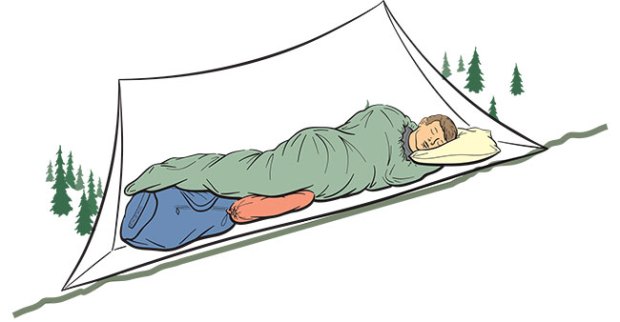
2. GET LEVEL: Pick a spot that’s as flat and level as possible so you’re not sliding downhill all night. Flat ground can be tough to find, so if sleeping on a slight incline is unavoidable, always have your head on the uphill part so all the blood doesn’t rush to your noggin.
3. CLEAR THE WAY: Before you go to bed, do a quick sweep of the spot you’ll be sleeping on to remove sticks, stones and other things. But leave the pine needles and leaves right where they are. They’ll give you a little extra padding, and leaving them will make less of an impact on the environment.
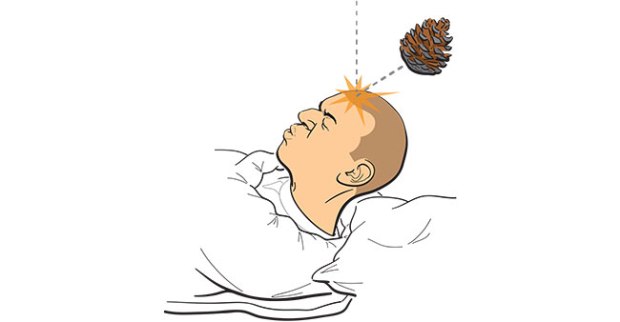
4. LOOK ABOVE: Check for dead trees, limbs, pine cones and other stuff that could fall on you in the night. Avoid those spots.
5. DO A STAKEOUT: Take the extra time to stake out the body of your tent and the guy lines on your rainfly. That way, if the wind whips up, you won’t be kept awake by the annoying flapping of the fly. Also, this will improve airflow and ventilation within your tent and will help you avoid your tent wetting through with morning dew and condensation.
6. KEEP IT ROLLED UP: If you’re going to sleep out under the stars (good for you! It’s one of Gear Guy’s favorite things to do), keep your sleeping bag rolled up in its stuffsack until it’s time to hit the hay. That way you’ll prevent your bag from getting wet from dew or humidity, and it’ll give the creepy crawlies less opportunity to get inside before you do.
7. BRING PJs: I’m not saying you ought to pack those Spider-Man pajamas, unless that’s how you roll. Just make sure you always have clean clothes to wear to bed. Maybe it’s simply a T-shirt and boxers, but having something that doesn’t smell like campfire, dinner or your own B.O. will help you sleep better. Bonus: It’ll keep your sleeping bag cleaner, too.
8. THROW IT AT YOUR FEET: Cold-weather tip: Whatever clothes you’re planning to wear in the morning, toss those in the bottom of your sleeping bag. They’ll keep your feet warmer, and the clothes will be cozy and warm when you get dressed in the morning. Sure they’ll be wrinkled, but get over it. You’re camping!
9. SLEEP IN YOUR CLOTHES: If it’s particularly cold, wear layers to bed. Long underwear (tops and bottoms), warm (clean) socks and a fleece jacket are a good start for frigid nights.
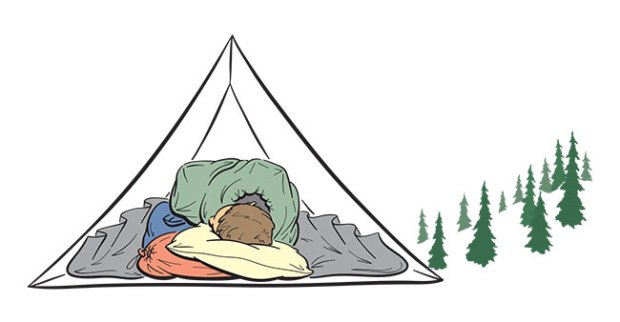
10. D-I-Y PILLOW: Don’t bring that huge, bulky pillow from your bed at home. Instead, make a do-it-yourself pillow. Use a stuffsack (or a fleece jacket) and fill it with your other clothing layers to make a soft mini pillow.
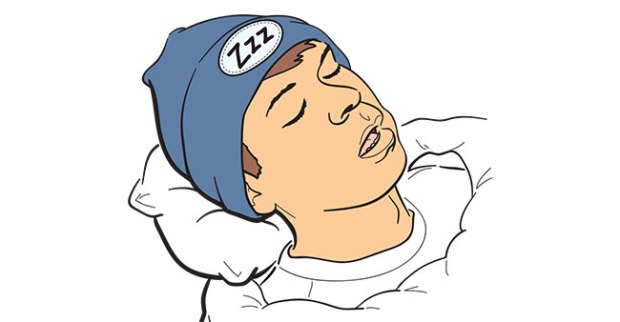
11. WEAR A HAT: We lose most of our body heat through our heads, so keep a stocking cap or balaclava close at hand. Then if you get chilly in the night, you can just slip it on and warm up.
12. SLEEP LIGHT: Keep a headlamp or flashlight at your side when you sleep; doing so is key to being able to find your way in the middle of the night—whether it’s an emergency or you’re just heading out to relieve yourself. Bonus: If it’s cold, keeping your headlamp inside your sleeping bag prevents the batteries from getting cold and losing their power.
The pee in the bottle tip is especially helpful to us older guys. There’s a reason they call it “golden age.”
Not bad advice except for the how to sleep on a hill. If you sleep head up hill with padding to elevate your legs you get a “hammock” effect and you’ll have one dire back in the morning. Better to sleep “sideways” to slope of hill with padding along length of downhill side. You will be much more comfortable. Want real comfort? Get a hammock and slerp on diagonal. Like sleeping in your bed at home!
I tend to disagree with #9. Sleeping bags are designed to work with your body heat and wearing clothes in it will actually prevent the bag from giving you the best warmth possible.
i take a dry sack with my “bed time” items. PJs, headlamp and a pillow case. Then I stuff the dry sack with clothes and slip it into the pillow case. I tried it once without the pillow case, but it sticks to your face.
I don’t always sleep well on camping trips, so I carry a Kindle with favorite books…a nice distraction until I get sleepy.
For car camping on snow, I try to have 5+ layers underneath me. Works well. Several layers of cardboard really insulates from the cold. Plus tent bottom, pad.
If you have a genuine Nalgene bottle, fill it with boiling water, tighten the lid and put it in a bottle cover or old wool sock. Toss it in your sleeping bag to preheat the bag, and the bottle will stay warm until morning. (Don’t try this with cheap plastic bottles–they will melt.)
Don’t breathe into your cold sleeping bag. It may feel warm but you are setting yourself up for more cold. Toss a hand warmer or two in your bag and wear a hat on your head. Keep your breath Out of your bag and let your bag warm up naturally, you will stay warmer and not have “cold spots”. If your bag touches your tent sides in the night it might wick (if cold) the dampness so be sure and put up barriers of clothes, or boots, or even a spare jacket etc. to keep from touching the wet tent…the fly usually helps a lot with this…assuming you have a rain fly.
My sleeping bag has a little zippered pouch in it. I always make sure when I out it away it has a little spray bottle of bug spray (which you can buy anywhere, about the size of a chap stick), and a few pairs of foam earplugs. Both come in handy when you get comfortable and realize you have bugs, or a loud snore going on.
A pee bottle does not really work for female venturers. I would recommend not drinking much water before you hit the sack.
On a slope, place tent so you’d roll. But put extra clothes or jackets under downhill side of your pad or bag to create a level shelf. Less required than trying to prevent sliding feet first downhill by stuffing under low end.
You have to get a wide mouth quart sized peanut butter jar, or a peanut jar.
Why is everyone talking about peeing, there were 12 other things in this list
I don’t know why the bottle would smell any more than say your dirty clothes or unwashed body as long as you’re careful. I had heard this old timer’s advice which also included sealing the bottle TIGHT and throwing it in the bottom of your bag. it’s like a hot water bottle to heat the bag. I’d guess that only works if you’re not getting out of the bag. If you’re going to the trouble to get up, out of the bag, and etc, you’re losing all the body heat anyway and all the bottle trick does is make it so you don’t have to walk far …
Peeing in a bottle really isn’t that discusting. And yes the bottle will attract animals but that’s why u put it outside of the tent. If its inside the anomalies will try to get in. If they are out side of your tent, who cares they can play with the bottle all night long and they won’t bother u because they’re not trying to get in
throw a hand warmer in the foot box of your sleeping bag
Peeing in a bottle then placing it outside your tent will attract animals
I agree
unless your in a very popular camp-ground, no it will not attract animals. Deer can be attracted and will even lick it up sometimes because the like the salty taste(personal experance). other wise no it will not attract animals. In fact it might even scare them away. (Most animals do not like the smell of humans and human urine has a very potent smell to it)
peeing in a bottle is kool but i pee like right out the tent
I had to pee in a bottle and lest just say the bottle was’nt big enough!
Pee is actually quite clean as your bladder keeps it hot enough to kill any germs. For the same reason you will sleep better in winter with an empty bladder as your body can heat your core instead.
To clarify on the sleep in your clothing bit. Make sure that it is clean and dry clothing. If it is not it will actually make you colder.
Cool Tips
(Not the bottle)
Adult Diapers are not the best solution and peeing in a bottle might get lots of funny looks if you get equipment inspections in camp.
If your like me and have bladder issues then a diaper is the best option. If your not sure I’d try them anyway as its easier to stash these then a loaded bottle.
You’d dump out the (if any) contents of the bottle in the morning.
its not worth the possible embarassment to pee in a bottle. if it is too “dangerous” to get out of your sleeping tent, then you need to set up camp in a different place. if its too dangerous to get out of your sleeping bag, then your doing something horribly wrong!
if ur having trouble getting up early on camping trips, like me, drink a lot of water before bed, then boom, your up, indians used this practice
peeing in a bottle is disgusting.
Instead of a pee bottle adult diapers.
Peeing in a bottle is disgusting.
yes
I agree.
Wow, that was helpful! I’ll have to take these into consideration on my next camp out!
-DoctorEvil
cool tips
Im going camping tommorow so i am glad that i saw this! :]
I constantly get up to pee in the middle of the night on Scout campouts (And them only for some reason!) and I finally got smart and told Dad I want a pee bottle for the Centennial camporee our council is having this weekend. For some INCREDIBLY stupid reason he won’t let me simply because he doesn’t think peeing in a bottle is “normal practice for boys.” Really? I’ve Googled and Googled some more, and you even have it. Not sure how he can not let me now.
Peeing in a bottle is kinda gross!
Peter why do you think peeing in a bottle is gross.
or you could just suck it up and take the cold! thats what i do! BUT if I had to I wouldn’t mind.
id pee in a bottle anytime
thanks this will really help me when i go on outings thx
xD
Sometimes the only thing you can do is camp, camp and camp more. I’ve camped since I was 7 years old and by now, the procedure is this: get in bed, take unnecessary layers off such as sweaters to roll up and put under your head to stuff your feet into, put the hat on, do an activity that makes you comfortable (reading, writing, drawing, praying…)and do it ’til you feel tired, then I sleep until 8 in the morning.
thx for the tips! It helped alot XD
If you can’t find a completely level area to put your tent to have as a sleeping area, then sleep with your feet downhill from your head on a 1/2 percent slope grade to avoid developing a headache after sleeping on a hillside slope for about eight hours. Don’t sleep sideways, as many people will end up rolling down the hillside during the night as they turn during their sleep. Only sleep with your head downhill from your feet as a first aid technique for the elevation of the feet above the head.
HOW DO YOU MEASURE THE SLOPE?
I went camping in -10 degree (Faranheit), and I didn’t have a hat, I got cold really quick. I ended up borrowing one for the night: it really helped
ROCK ON!!!!!
I think these tips are very helpful. A couple of years back on my school’s camping trip our group didn’t brush away rocks and twigs. We got poked and scratched all night long. I used these tips on one of my scout outings where there were only hills. Having your noggin at the top of the hill really helps.
Cleaning up the area before you pitch your tent really does help. There are so many times I lie down to go to sleep and I feel a rock in my back, which turns the whole sleeping experiance into a nightmare!
This was very helpful. I’m going to philmont in about a month and will probably experience all of these situtions. Since I’ll be out on the trail for 2 weeks, getting a good night’s rest will be greatly neeeded.